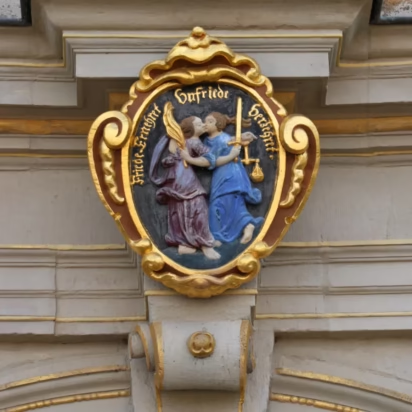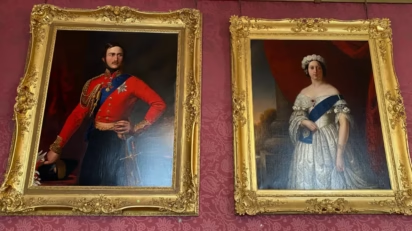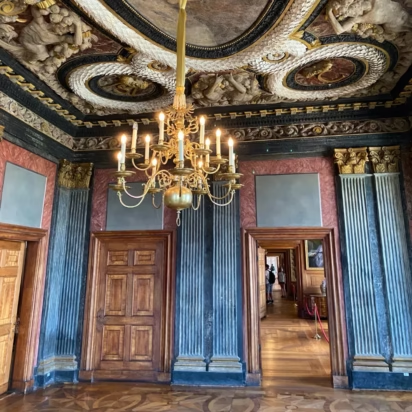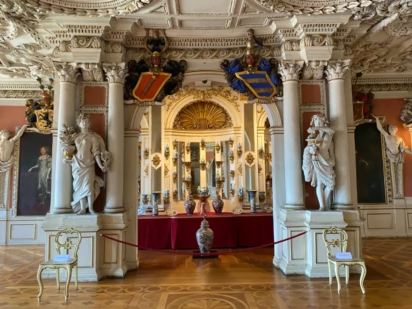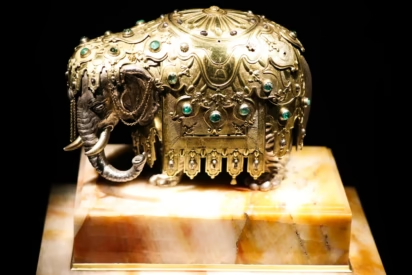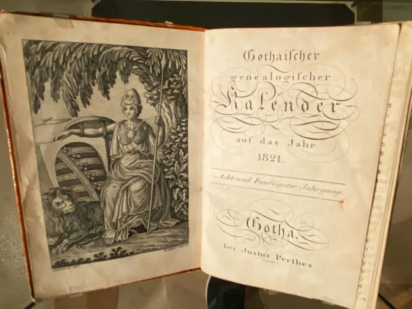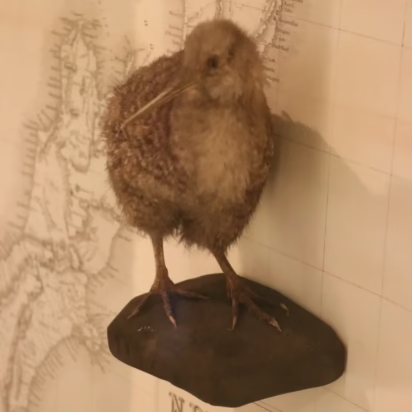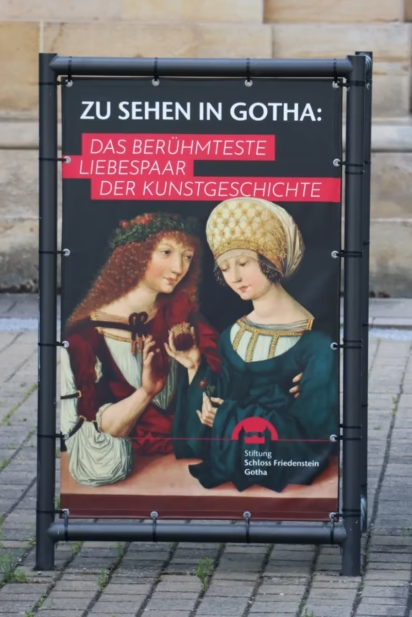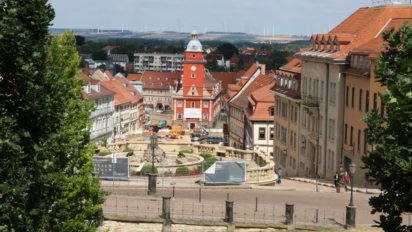Schloss Friedenstein, a baroque castle with several museums, the Ekhof Theatre, and the ducal art collection are the top sights to see in Gotha, Thuringia.
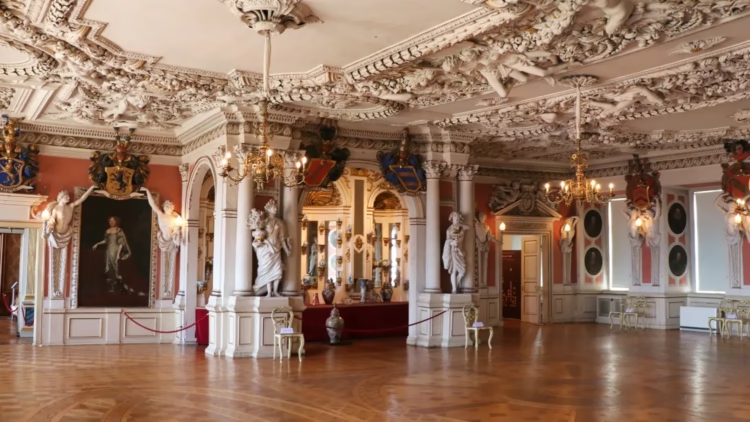
The Baroque Universe of Gotha (Das Barocke Universum Gotha), the fine marketing slogan for Schloss Friedenstein, refers to a unique ensemble of baroque buildings, interiors, a theatre, art, and parks in Gotha in Thuringia in central Germany. These sights with several museums date mostly from the period when Gotha was the capital and residence city of the dukes of Saxe-Gotha (including at times Altenburg, Coburg, and others) between 1640 and 1918. Highlights of a visit to Friedenstein is the fine palace interiors and the high-quality art collection in the Ducal Museum.
Visit the Baroque Universe of Gotha
The top Baroque Universe of Gotha (Das Barocke Universum Gotha) sights open to the public are:
- Schloss Friedenstein — the largest and best-preserved early Baroque palace in Germany. It was never destroyed and preserved original baroque, rococo, and neoclassical interiors.
- Ekhof Theater — an original baroque court theater with the only working 17th-century stage machinery in existence.
- Schlosspark — the earliest English landscape style park planned on the European continent.
- Fine art, applied and decorative art, coins, and nature specimens displayed in four museums.
- Schlosskirche – the baroque court chapel (usually not open for sightseeing).
- Herzogliches Museum — an extensive art collection in a separate historicist building in the park.
Visit Baroque Schloss Friedenstein in Gotha

Schloss Friedenstein (literally Stone of Peace Castle) in Gotha is the largest surviving early Baroque palace in Germany. It was built around an open rectangular courtyard with the main four-story north wing measuring 100 m long while the three-story east and west wings are 140 m each. The southern side of the courtyard is closed off with a relatively low protection wall — it replaced the original single floor riding hall already in the early 18th century.
The castle was built in a relatively short 12-year period between 1643 and 1654, as the ducal seat for Ernst I the Pious (die Fromme) of the duchy Saxe-Gotha that was only founded in 1640. (Altenburg was added in 1672.) He named the castle in honor of the Peace of Westphalia (1648) that brought peace to Germany after 30 years of war. A Friedenskuss (kiss of peace) portrayal on a shield confirmed the name above the main entrance of the palace (facing the old town).
Schloss Friedenstein is a typical large central German residential castle (Residenzschloss) that provided living quarters for the court but also representation rooms, office space, and commercial and craft quarters. Friedenstein was never destroyed in wars, nor severely damaged by fire, or significantly altered allowing the relatively plain white exterior with yellow detailing to remain largely true to the original.
The palace building now houses three museums — castle, nature, local history — and the baroque Ekhof theatre. Although interesting, the exhibits are often overshadowed by the magnificent palace interiors that range from the original baroque to historicism. The magnificent ducal art collection is in the large historicist museum building erected in 1879 in the park downhill from the palace.
Duchy of Saxe-Coburg and Gotha

The former Saxon states that are now mostly combined into the federal state of Thuringia (Thüringen) were prime examples of German fragmented small states (Kleinstaaterei), where territories were frequently divided amongst sons to create new, fully sovereign states. This resulted in many fine palaces, art collection, and of course a good supply of nobles for royal marriages.
Leaving aside finer details, the simplified history of Saxe-Gotha (Sachsen-Gotha) is as follows: the duchy Saxe-Gotha was carved out of Saxe-Weimar in 1640 with the first duke Ernst I from the Ernestine branch of the Wettin dynasty. Altenburg was added in 1672. Shields on the arches of the arcades facing the central courtyard remind of the extensive properties ruled by the family — the same display of power is repeated in the banqueting hall.
The Saxe-Gotha-Altenburg lined died out in 1825. The duchy was split again and Gotha became part of the duchy of Saxe-Coburg-Saalfeld, which had to cede Saalfeld to Saxe-Meiningen. (The finer details were much more complicated.) The duchy disbanded in the German Revolution in 1918, and although the family still exists, the nobility has no legal status in Germany.
The Saxon Wettin dynasty was very prestigious but the Ernestine branch after the 18th century never so powerful as to physically threaten any territory making the family ideal for royal marriages throughout Europe. Although small in size — not even 2,000 square km (760 sq miles) with less than 250,000 inhabitants in the early 20th century — Saxe-Coburg and Gotha would become the ruling houses of Britain, Belgium, Portugal, and Bulgaria. Through the female line, the family is also linked to many further noble houses including the current King of Sweden.
British Royals and the House of Saxe-Coburg and Gotha
Two prominent marriages linked the British kings with Gotha and strengthened the German blood in the British royal family:
Princess Augusta of Saxe-Gotha-Altenburg (1719-1772) married Frederick, Prince of Wales in 1736. Despite their nine children, it was an unhappy marriage. Augusta never became queen, as Frederick died before his father, King George II of Great Britain (and Elector Hanover), who himself was born in Schloss Herrenhausen famous for its fabulous baroque Great Garden in Hannover. Their son, properly German from both parents, became King George III of Great Britain (later the United Kingdom and also of Hanover).
The most famous member of the family was Prince Albert (1819-61) who never ruled in Germany but in 1840 married Queen Victoria of Great Britain, etc. Their children married into royal families throughout Europe but their son ascended to the British throne in 1901, as King Edward VII to change the British royal family from the House of Hanover to the House of Saxe-Coburg and Gotha.
The same house still rules in Britain but changed the too German name to the House of Windsor in 1917, only relatively late into the First World War. The Belgian royal family similarly dropped the name Saxe-Coburg and Gotha in 1920 in favor of simply Belgium (but of course in three official languages).
Museums in Schloss Friedenstein

The two cultural-historical museums inside Schloss Friedenstein — the Castle and Local History museums — are moving around a bit while restoration projects are ongoing. These museums are typical for the genre and include things such as porcelain, decorative items, clocks, militaria, musical instruments, and coins. The family generally had good taste with the artistic quality of many items of a similarly high standard.
While the castle museum focuses on the court and nobility — visitors included Frederick the Great, Goethe, Schiller, and Napoleon — the local history has more items from the lives of ordinary people.
Schlossmuseum Gotha
The Castle Museum is in the north and west wings of Schloss Friedenstein. The oldest representation rooms and ducal apartments in the palace were decorated in the late-17th century in heavy baroque stucco by Giovanni Caroveri. The Rococo rooms are from the mid-18th century to the designs of Gottfried Heinrich Krohne.
In the west wing — currently being restored — are the stylish late-18th-century neoclassical apartments of Duke Ernst II of Sachsen-Gotha-Altenburg. The marble room and music room have wall decorations by Friedrich Wilhelm Eugen Doell.
The Audience Chamber (Audienzzimmer) was the most important representation room but the largest room is the banqueting room. The heavy Baroque stucco in this Festsaal is a bit overwhelming and makes the ceiling appears a bit lower than it actually is — Neptune’s knee hanging straight down is not helping either. The life-size statues are of the first three dukes and their wives, while others are allegories of the seasons.
As with most other palaces in Europe, much is made of the history and influence of the ruling family. Despite a name change, the British and Belgian royal families are from the House of Saxe-Coburg and Gotha, while further royal families are linked through the female line.
Typical for a German museum, it is not hidden that the last ruling duke, Carl Eduard, lost this throne after the revolution of 1918 and died in 1954 in relative poverty largely due to heavy fines imposed for his active support to the Nazis and the loss of all his properties in the Soviet Zone, later East-Germany. It is often argued that he escaped a long prison sentence only due to his royal connections — in 1973 his grandson became King Carl XVI Gustaf of Sweden.
Kunstkammer
The apartments are decorated with art and furniture from the 17th to 19th centuries. The best paintings are in the Ducal Museum but the apartments, and especially the Kunstkammer, have some fine clocks, porcelain, silverware, and curiosities.
Several elephants are on display but the real treasure is the small bejeweled silver and gold elephant used as a paperweight by Johann Melchior Dinglinger (around 1710) — it came from the same mold as the famous Der Hofstaat zu Delhi am Geburtstag des Großmoguls Aureng-Zeb that is now in the Grüne Gewölbe in Dresden.
The coin collection is the fourth largest in Germany (after Berlin, Dresden, and Munich) but currently closed due to renovation.
Museum of History
The local history museum (Historisches Museum Gotha) is due to move to the upper floors of the palace in coming years. Therefore currently only 62 objects are on display ranging from a Neanderthal scraping tool to a symbolic coffin for the SED (governing party of East Germany) signed by amongst others former West German chancellor Willy Brandt.
Many Germans were strong supporters of Napoleon — both during his reign and afterward. In 1808, he visited Friedenstein and Duke August exchanged a golden box for Napoleon’s hat — now on display in the Kunstkammer in the Castle Museum. The history museum must do with a plaster death mask of Napoleon. It is one of around 50 known copies made around 1833 from the original in the Musée de l’Armée.
Also on display is a copy of the Almanach de Gotha (Gothaischer Hofkalender) — published from 1763 to 1944, “Gotha” was the authority on the classification of European royalty and high nobility. Its extensive archives were destroyed by the Soviets in 1945. The former German nobility often uses prince or duke, etc in their names but although they may play prince and countess in private (and in the gossip magazines), the nobility has no titles or special legal status in Germany.
Ekhof Theater

The Ekhof Theater, built in the 1680s in the west tower of Schloss Friedenstein, is the only theater in the world with functioning stage machinery from the 17th century. Although updated in 1774, the basic stage machinery dates from 1683. Around a dozen helpers are needed to operate the full mechanism to change the scenery in as quick as 8 seconds. Special effects such as thunder and wind amazed the baroque audiences.
In 1775, the duke founded the first permanent Court Theater ensemble in Germany. They worked only for the court and were partly financed by opening the court theater also to the paying public. The next four years were the glory days of the Ekhof theater and saw 872 performances. Operas were popular as were works by Shakespeare, Goldoni, Molière, Voltaire, Diderot, and Lessing — it was too early for Goethe or Schiller. However, with 11,000 inhabitants Gotha was too small to afford the expense of a permanent theater and the experiment came to an end by 1780.
The theater saw little use after a concert hall opened in town in 1840. During the second world war, it was even used as a depot for car spare parts. It was part of the local history museum thereafter but since the mid-1960s was again used for theatre performances.
The baroque theater is still in use, especially during the annual Ekhof Festival. Ticket sales for the summer festival starts usually November or even October the preceding year and usually sell out fast, as only 165 seats are available per performance.
Museum of Nature in Gotha
The Museum of Nature recently moved back into the castle after being inside the art museum building for decades. It used the same entrance as the theater in the west tower, which explains the name Animals in the Towers for its taxidermy display.
The varied collection of stuffed animals is popular with families. The natural history collection display will be expanded in coming years. The collection was already begun in 1640 and is much bigger than the small number of items currently on permanent display. In the ducal competitive world of smaller Saxons states, Weimar became the home of humanism and German classicism while Gotha saw itself as a center of natural science.
Visit the Herzogliches Museum (Ducal Museum) in Gotha

The Herzogliches Museum (Ducal Museum) is in a large late-19th-century historicist building in the landscape park of Schloss Friedenstein — it is the only museum in the Baroque Universe of Gotha not inside the castle building itself. The core of this impressive exhibition is still the art collection of the former dukes of Sachsen-Gotha. The best-known work here is the Gotha Lovers but the museum has a fine collection of old German and Dutch masters, sculptures, porcelain, graphic art, Japanese lacquerware, and one of the oldest Egyptian collections in Europe.
The Gotha Lovers (Gothaer Liebespaar) from around 1480 is the most important painting in Gotha. It shows a man and a woman together in the same frame and is considered the first large portrayal of a non-liturgical couple in German art. The museum also has paintings by Lucas Cranach, Peter Paul Rubens, romantic painter Casper David Friedrich, and several by Tischbein
See Visit the Herzogliches Museum (Ducal Museum) in Gotha for a more detailed description.
Schlosspark Friedenstein in Gotha
The 37-ha large Schlosspark is mostly an English landscape garden. Part of the layout was planned already in 1765 making it the first of its kind on the European continent and thus older than the famous gardens of Dessau on the banks of the Elbe in Saxony-Anhalt.
Goethe described the park as “heavenly” and although the park remains pleasant enough, for most foreign visitors it is of lesser interest than the palace and museums.
Visitors Information for the Baroque Universe of Gotha

Opening Hours of Schloss Friedenstein
The Ducal Museum (Herzogliches Museum) and the museums in Friedenstein Castle are open Tuesday to Saturday from 10:00 to 16:00, closing at 17:00 from April to October.
The museums are closed on Monday but usually open if a holiday.
The Schloss Park is unfenced and thus always freely accessible.
Admission Tickets to Friedenstein in Gotha
Admission tickets are available at the Ducal Museum or from the main ticket office in the passage in the north wing of the castle.
The Friedenstein-Karte is €10 and includes all sights on the same day. It is also possible to buy individual tickets for €5 for the Ducal Museum, or the Nature Museum and Ekhof Theater.
Admission is free for children under 17.
Photo permission is €5 for the day.
Audio guides are available but almost all descriptions inside the museums are in both German and English.
Restaurant Pagenhaus in the northwestern corner of the palace (nearest to the town center) offers both good local cuisine meals or simpler coffee and cake — usually open from noon. Otherwise, it is a short downhill walk to many further options in the town center. There is also a basic cafe in the basement of the Ducal Museum building.
Transportation to Gotha
Gotha in Thüringen is easily reached on public transportation or by car. The castle is on a hill inside the large park, which is in-between the old town center and the modern train station.
The parking lot at the south side of the palace — P20 Südrampe Schloss — charges but is on the same level as the palace. Parking at the Ducal Museum and on the edge of the park is mostly free but note any time restrictions.
Gotha train station is on the south side of the modern town away from the historic center. It is a pleasant ten-minute walk to the castle. From the station, follow Kunstmühlenweg one block north and then walk through the park from Parkstraße — across from the Netto supermarket. The Länder-Tickets (state tickets) are great value when traveling only on local trains and buses in Thuringia, Saxony, and Saxony-Anhalt — the same price; all cover travel in all three states. See trains to Gotha for timetables.
Gotha has only a limited number of hotels — see Tripadvisor — but Thuringia is fairly small with good transportation making it of little importance in which city visitors sleep while sightseeing. Eisenach, Erfurt, and Weimar are nearby, as are many other pleasant smaller towns with rich cultural heritage.
See also:
- Visit the Herzogliches Museum (Ducal Museum) in Gotha for the marvelous art collection of the duchy.
- Flickr for more photos of Schloss Friedenstein and the museums.
